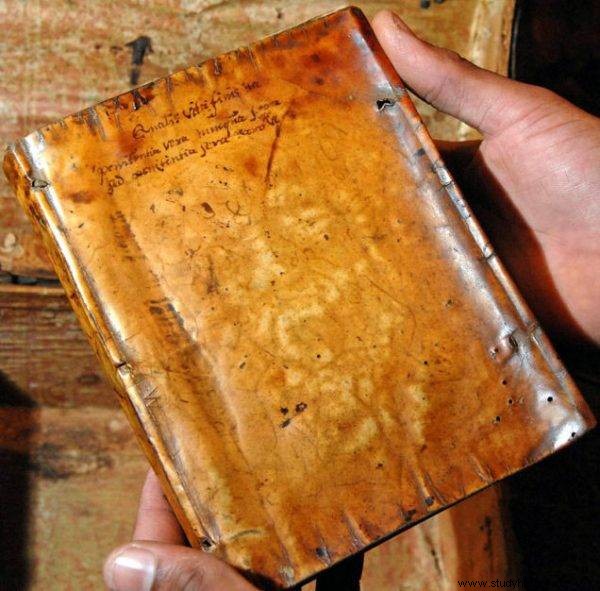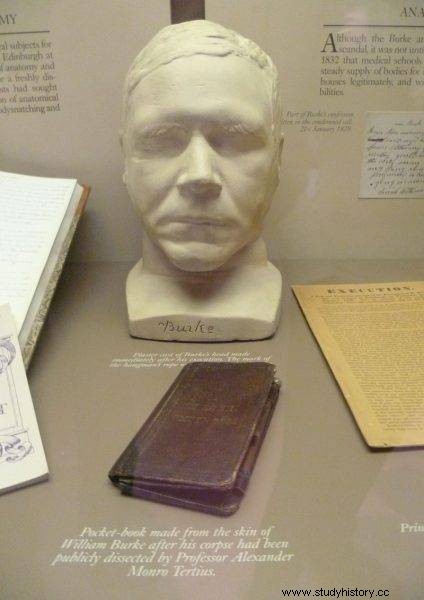Although it is hard to believe, in the collections of many respected libraries of the world you can find books bound in human skin. Where did these exhibits come from and what is their history? Megan Rosenbloom's investigation opens dark archives of the history of medicine, crime and collecting.
A copy of Des destinées de l'ame I was holding in my hands is not much different from other leather-bound books of this era, except that the cover design is a bit simpler. Before the development of the fingerprint peptide test, the most common study was the arrangement of the hair follicles on the skin of the luminaire to determine which animal it came from.
Antiquities still use this method to describe rare books for sale. It is based on the observation that human hair follicles arrange themselves in the skin differently from that of a cow or a pig. Some conservation laboratories use powerful microscopes for this purpose.
Tattoo on human skin
For most of the most common applications, this method works, but is not always reliable. In the tanning process, the skin stretches and warps in an unpredictable way, so recognizing whether the follicles are triangular or diamond shaped can be quite a subjective issue. The age of an object can also obliterate the bellows arrangement. The consequences are insignificant if the bookseller confuses morocco (goatskin) for calfskin. However, the difference in weight and price between a book bound in animal and human skin is already serious .
In 2014, the Harvard library tested three book bindings from three different parts of the collection using the PMF method to see if they were made of human skin. Human origin was confirmed in the case of Des destinées de l'ame . The other two alleged anthropermic books turned out to be bound in sheepskin.

Stories of using human skin to make books date back to the 13th century.
One of them, a publication by Juan Gutiérrez from 1605 Practicarum quaestionum circa leges regias Hispaniae ( Practical questions about the laws of Spain ) was usually kept in the Law School library, but was undergoing maintenance during my visit so I couldn't see her.
So I went to the medical library to see the other fake. When I arrived at the Countway Library, an employee of the Rare Book Department spoke the magic words to the ears of every researcher and researcher:- Jack told me to tell you that he has prepared some surprises for you .
She meant the librarian Jack Eckert, whom I had come to visit. She reached on the shelf with the ordered materials and read aloud the inscription on the envelope:- Tattoo on human skin ... Her smile turned to a scowl. I laughed nervously. - You must be thinking, "What is this woman packing me into today?" . - People never get bored here She sighed, handing me a heavy white envelope.
Secret content
People generally think that librarians sit and read books all day long. Dreams! Under certain circumstances this job can be surprisingly dangerous . I once had a trip myself with a box of rare medical supplies donated to our library.
I felt some crumpled brown paper wrapped around mysterious objects in a cardboard box and felt a sharp prick on my finger. Glancing at the gathering drop of blood, with my other hand I discovered what attacked me so much. It was a small metal casket, similar to the cans that mints are sometimes sold in:a travel medicine kit from the early 1900s.

The text is an excerpt from Megan Rosenbloom's book “Dark Archives. An investigation in search of books bound in human skin ”, which has just been published by Znak Literanova. Buy now "
I opened it and was horrified to see broken vials of horrifying substances like strychnine and morphine. There was also a needle in the box - soiled with God knows what, coming from God knows when - which had to come out through the crack and prick me . I sat in my sad office in the basement and life passed before my eyes. "Really I'm gonna finish this?" I wondered, trying to calm my breathing so that I wouldn't hyperventilate.I survived and learned a valuable life lesson:never put your hand in a place where you cannot see the inside. So now, in the Countway Library, I was trying to get the mysterious contents out of the envelope, not packing the squares blindly inside. Eventually this item landed in my hand.
Human skin again!
The specimen had detached from the cardboard backing - a centuries-old, tanned piece of leather was touching mine. Jesus on the cross was tattooed on it, surrounded by other people. The skin, as rough and brittle as stale crackers, was clearly distinguished by hair follicles. On the reverse side, there were brown patterns - à la Vincent van Gogh, if he had passed through a scatological period in his work - probably remnants of the glue that once attached the specimen to the rootstock.
It is true that I am delighted to have the privilege of seeing extremely rare items, getting to know the story first-hand, touching it and feeling it, but let's be clear:sometimes this work gives you goose bumps. I have a higher threshold of immunity to such a macabre than many other people, but I am not immune to it.

The book is bound in the skin of the criminal William Burke. Such "desecration of a corpse" was also part of the punishment for the crimes committed.
I put the tattooed skin back in the envelope and returned it to the librarian. - Well, it was gross, even for me . - Do I want to see it? The librarian wondered, and we both shook our heads at the same time. - We have a few more things for you ... Oh, human skin again!
With mock enthusiasm, she pulled out a briefcase containing another white envelope and a note that read:" Human tanned leather." The skin of a white man, as well as the skin of a color man, tanned at Mullen's Tannery in North Cambridge in 1882 ". However, there was only one specimen of leather in the envelope.
It was much thicker than the one viewed previously and had a disturbing looking hole. I realized later that it was probably a navel. As I was driving to Cambridge, it never occurred to me, jet lagged, that my query might deprive me of my appetite. And now my stomach rolled up my throat. There was one thing Eckert was right:these specimens were surely a surprise.
Source:
The text is an excerpt from Megan Rosenbloom's book “Dark Archives. An investigation in search of books bound in human skin ", which has just been released by the Znak Literanova publishing house.
